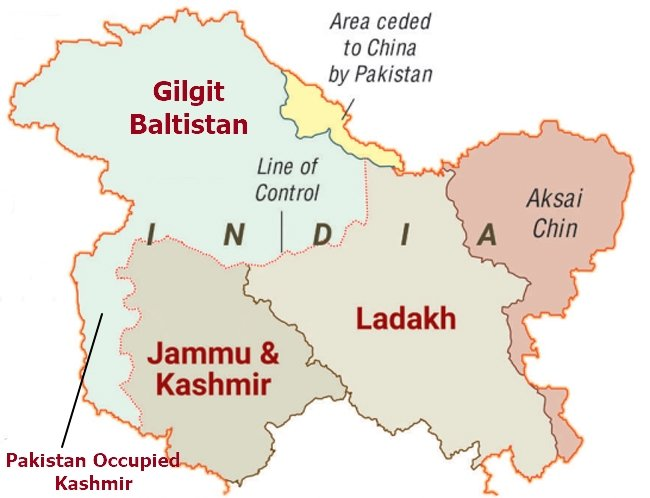Provincial Status to Gilgit-Baltistan: Pakistan | 02 Aug 2021
Why in News
Recently, it has been reported that, Pakistani authorities have finalised a law (26th Constitutional Amendment Bill), to award provisional provincial status to strategically located Gilgit-Baltistan.
Key Points
- About Gilgit-Baltistan:
- Gilgit-Baltistan is one of the disputed territories of India.
- It is a chunk of high-altitude territory located on the north western corner of the Union Territory of Ladakh.
- It is located strategically as it borders Pakistan, Afghanistan and China.
- Background of Gilgit-Baltistan Dispute:
- The region is claimed by India as part of the erstwhile princely state of Jammu & Kashmir as it existed in 1947 at its accession to India.
- Maharaja Hari Singh, the last Dogra ruler of J&K, had signed the Instrument of Accession with India on 26th October 1947.
- However, it has been under Pakistan’s control since 4th November, 1947, following the invasion of Kashmir by tribal militias and the Pakistan army.
- Following this invasion, India moved to the United Nations Security Council to raise the issue of Pakistan’s invasion, on 1st January 1948.
- The UN Security Council passed a resolution:
- Calling for Pakistan to withdraw from all of Jammu and Kashmir and then India had to reduce its forces to the minimum level following which a plebiscite would be held to ascertain people’s wishes.
- However, no withdrawal was ever carried out and it remains a point of contention between two countries.
- The region is claimed by India as part of the erstwhile princely state of Jammu & Kashmir as it existed in 1947 at its accession to India.
- Current Status:
- Gilgit-Baltistan is an autonomous region now and after the bill is passed, it will become the 5th province of the country.
- Currently, Pakistan has four provinces namely Balochistan, Khyber Pakhtunkhwa, Punjab, and Sindh.
- Presently, it has been ruled mostly by executive orders.
- Until 2009, the region was simply called Northern Areas.
- It got its present name only with the Gilgit-Baltistan (Empowerment and Self-Governance) Order, 2009, which replaced the Northern Areas Legislative Council with the Legislative Assembly.
- Gilgit-Baltistan is an autonomous region now and after the bill is passed, it will become the 5th province of the country.
- Reasons for Making Gilgit-Baltistan a Province:
- Gilgit-Baltistan is the northernmost territory administered by Pakistan. It is Pakistan’s only territorial frontier, and thus a land route, with China.
- The Gilgit-Baltistan region is at the centre of the USD 65 billion China Pakistan Economic Corridor (CPEC) Infrastructure development plan.
- The CPEC has made the region vital for both countries. The CPEC, which connects Gwadar Port in Pakistan's Balochistan with China's Xinjiang province, is the flagship project of China’'s ambitious multi-billion-dollar Belt and Road Initiative (BRI).
- Some experts on India-Pakistan relations also assert that Pakistan’s decision might have come from India’s reassertion of its claims after the 5th August, 2019 reorganisation of Jammu & Kashmir.
- Gilgit-Baltistan is the northernmost territory administered by Pakistan. It is Pakistan’s only territorial frontier, and thus a land route, with China.
- India’s Stand:
- India maintains the Government of Pakistan or its judiciary has no locus standi on territories illegally and forcibly occupied by it.
- India has clearly conveyed to Pakistan that the entire Union Territories of Jammu and Kashmir and Ladakh, including the areas of Gilgit and Baltistan, are an integral part of the country by virtue of its fully legal and irrevocable accession.
- India has protested to China over the CPEC as it is being laid through Pakistan-occupied Kashmir.

